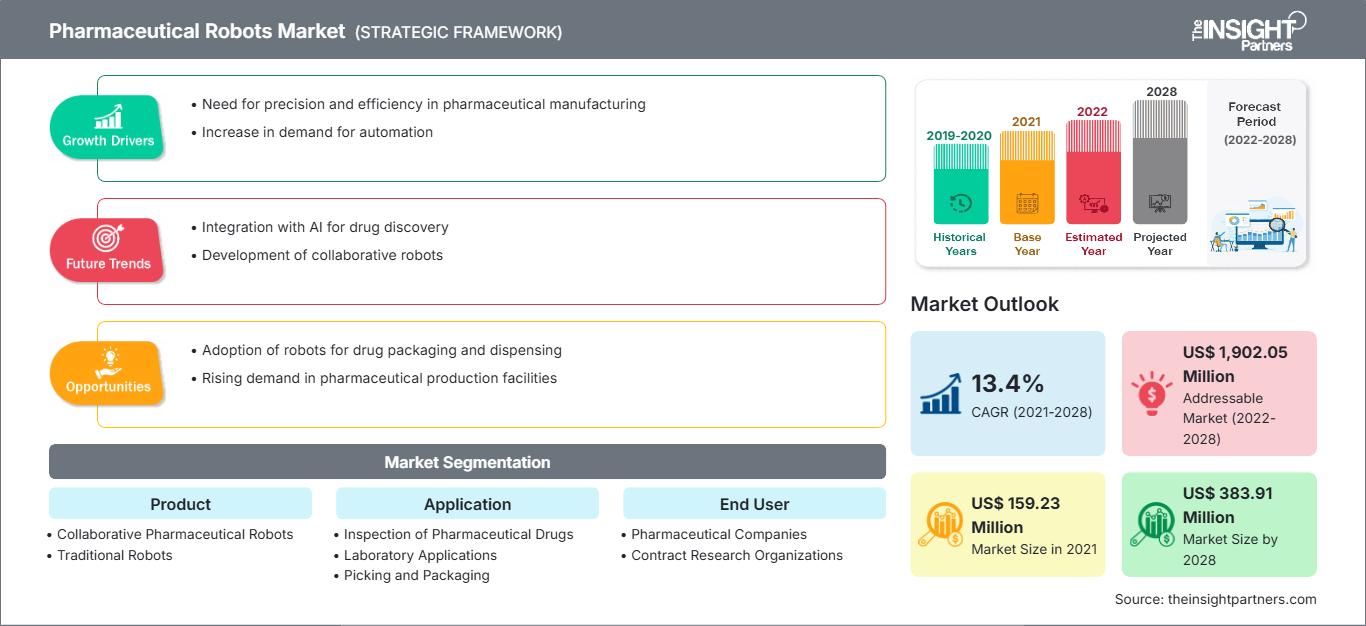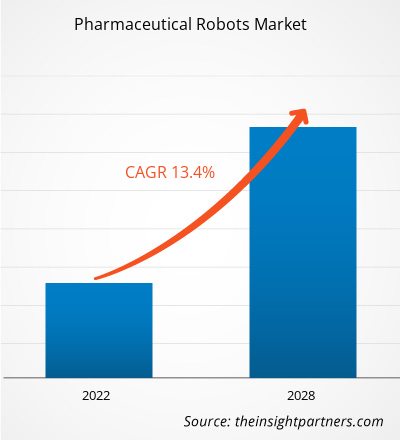[Rapport de recherche] Le marché des robots pharmaceutiques devrait atteindre 383,91 millions de dollars américains d'ici 2028, contre 159,23 millions de dollars américains en 2021 ; sa croissance devrait atteindre un TCAC de 13,4 % entre 2021 et 2028.
L'industrie pharmaceutique exige une production de médicaments efficace et précise. Ainsi, l'utilisation de robots dans la fabrication pharmaceutique améliore la qualité et réduit les coûts et les délais. Les robots s'avèrent avantageux pour le remplissage, l'inspection, le conditionnement, les laboratoires et la fabrication de médicaments personnalisés. Un système robotique est un type d'automatisation doté de plusieurs axes de mouvement et pouvant être programmé pour exécuter n'importe quelle fonction.
Le rapport offre des informations et une analyse approfondie du marché des robots pharmaceutiques en mettant l'accent sur divers paramètres tels que les tendances du marché, les avancées technologiques, la dynamique du marché et l'analyse du paysage concurrentiel des principaux acteurs du marché à travers le monde. Il inclut également l'impact de la pandémie de COVID-19 sur le marché dans toutes les régions. L'impact de la pandémie et la baisse des activités de recherche mondiales ont également affecté les opérations et la performance financière de plusieurs entreprises du marché des robots pharmaceutiques. L'OIE, l'Organisation mondiale de la santé animale, soutient la recherche dans ses recherches en cours et sur les autres implications de la COVID-19 pour la santé animale et la santé publique avicole. L'organisation contribue également à l'évaluation, à la gestion et à la communication des risques. L'OIE a déployé un système de coordination des incidents pour coordonner ces activités. De plus, la pandémie de COVID-19 et les confinements qui en ont résulté ont eu un impact significatif sur les secteurs de l'élevage et de la volaille dans différents pays du monde. L'écart entre l'offre et la demande se réduit progressivement avec l'ouverture des chaînes de commercialisation et les mesures supplémentaires prises par les administrations locales pour combler les goulots d'étranglement des systèmes de distribution. Il est également envisagé que l'impact perdure et ait une incidence considérable sur les moyens de subsistance, l'emploi et l'économie globale du secteur. Le marché des robots pharmaceutiques est segmenté en fonction du dosage, de la maladie, de la technologie et de la région. Le marché, basé sur la région, est segmenté en Amérique du Nord, Europe, Asie-Pacifique, Moyen-Orient et Afrique, et Amérique du Sud et centrale.
Aperçu du marché
Personnalisez ce rapport en fonction de vos besoins
Vous bénéficierez d’une personnalisation sur n’importe quel rapport - gratuitement - y compris des parties de ce rapport, ou une analyse au niveau du pays, un pack de données Excel, ainsi que de profiter d’offres exceptionnelles et de réductions pour les start-ups et les universités
Marché des robots pharmaceutiques: Perspectives stratégiques

-
Obtenez les principales tendances clés du marché de ce rapport.Cet échantillon GRATUIT comprendra une analyse de données, allant des tendances du marché aux estimations et prévisions.
La robotique cloud est un domaine émergent de la robotique ancré dans le cloud computing, le stockage cloud et d'autres technologies Internet, centré sur les avantages des infrastructures convergées et des services partagés. La connexion des robots au cloud augmente la puissance de calcul, le stockage et les communications. Les robots cloud communiquent entre eux, facilitant ainsi l'exécution des opérations.
La plateforme Google Cloud Robotics combine l'IA, la robotique et le cloud pour permettre l'ouverture d'un écosystème de solutions d'automatisation utilisant des robots collaboratifs connectés au cloud. Associés à l'IA et aux services d'apprentissage automatique, les robots seront capables d'exécuter efficacement des processus dans des environnements hautement dynamiques de l'industrie manufacturière. De plus, dans ce secteur, le cloud est un allié pour le traitement de grandes quantités de données. Par exemple, Exscientia et Celgene, une société biopharmaceutique, ont annoncé un accord de 19,64 millions d'euros en 2019 pour accélérer la découverte de médicaments contre le cancer et les maladies auto-immunes. En 2020, Exscientia a également annoncé une collaboration avec d'autres entreprises pour trouver d'éventuels médicaments contre la COVID-19. L'entreprise a ainsi désormais accès à un ensemble de molécules, comprenant des médicaments et d'autres produits chimiques, testés avec succès sur l'homme. L'entreprise comptait analyser cette liste à la recherche de médicaments susceptibles de combattre le virus. La technologie d'Exscientia analyse les vastes bases de données et permet de prédire avec précision les composés qui ne génèrent pas d'effets secondaires pour atteindre l'objectif souhaité. De même, en 2020, une autre société pharmaceutique, Boehringer Ingelheim, s'est associée à une société de biotechnologie, Click Therapeutics, pour produire 500 millions de dollars de traitements numériques. Plus précisément, les deux entreprises prévoyaient de collaborer au développement et à la distribution d'une application mobile destinée à aider les patients atteints de schizophrénie et de troubles cognitifs. Par ailleurs, IBM a créé RoboRXN, un laboratoire de chimie qui utilise l'IA, le cloud computing et la robotique pour développer des médicaments depuis le domicile des chercheurs. Des logiciels cloud, dotés de protocoles de sécurité appropriés, peuvent être adoptés pour faciliter l'intégration et l'automatisation. Son utilisation permet de réduire la paperasserie des entreprises et de simplifier la gestion des données. Ainsi, la robotique cloud devrait devenir la tendance du marché des robots pharmaceutiques à l'avenir.
Informations produit
En fonction du produit, le marché des robots pharmaceutiques est segmenté en robots pharmaceutiques collaboratifs et robots traditionnels. En 2021, le segment des robots pharmaceutiques collaboratifs devrait représenter la plus grande part de marché, tandis que les robots traditionnels devraient connaître le TCAC le plus élevé du marché au cours de la période de prévision. La croissance de ce segment est attribuée à l'augmentation de l'utilisation des robots pour la distribution, le tri, l'assemblage de kits et la maintenance de machines légères, ainsi que pour des applications plus traditionnelles liées au conditionnement et autres.
Informations application
En fonction de l'application, le marché des robots pharmaceutiques est segmenté en inspection de médicaments, applications de laboratoire, prélèvement et conditionnement. Le segment de l'inspection des médicaments pharmaceutiques devrait détenir la plus grande part de marché en 2021 et devrait enregistrer le TCAC le plus élevé du marché au cours de la période de prévision.
Informations basées sur l'utilisateur final
Le marché des robots pharmaceutiques est segmenté en fonction de l'utilisateur final : sociétés pharmaceutiques, laboratoires de recherche et organismes de recherche sous contrat. Le segment des sociétés pharmaceutiques devrait détenir la plus grande part de marché en 2021, tandis que le segment des laboratoires de recherche devrait enregistrer le TCAC le plus élevé du marché au cours de la période de prévision.
Les acteurs du marché des robots pharmaceutiques adoptent des stratégies organiques, telles que le lancement et l'expansion de produits, pour étendre leur présence et leur portefeuille de produits à l'échelle mondiale et répondre à la demande croissante.
Aperçu régional du marché des robots pharmaceutiques
Les tendances régionales et les facteurs influençant le marché des robots pharmaceutiques tout au long de la période de prévision ont été analysés en détail par les analystes de The Insight Partners. Cette section aborde également les segments et la géographie du marché des robots pharmaceutiques en Amérique du Nord, en Europe, en Asie-Pacifique, au Moyen-Orient et en Afrique, ainsi qu'en Amérique du Sud et en Amérique centrale.
Portée du rapport sur le marché des robots pharmaceutiques
| Attribut de rapport | Détails |
|---|---|
| Taille du marché en 2021 | US$ 159.23 Million |
| Taille du marché par 2028 | US$ 383.91 Million |
| TCAC mondial (2021 - 2028) | 13.4% |
| Données historiques | 2019-2020 |
| Période de prévision | 2022-2028 |
| Segments couverts |
By Produit
|
| Régions et pays couverts |
Amérique du Nord
|
| Leaders du marché et profils d'entreprises clés |
|
Densité des acteurs du marché des robots pharmaceutiques : comprendre son impact sur la dynamique des entreprises
Le marché des robots pharmaceutiques connaît une croissance rapide, porté par une demande croissante des utilisateurs finaux, due à des facteurs tels que l'évolution des préférences des consommateurs, les avancées technologiques et une meilleure connaissance des avantages du produit. Face à cette demande croissante, les entreprises élargissent leur offre, innovent pour répondre aux besoins des consommateurs et capitalisent sur les nouvelles tendances, ce qui alimente la croissance du marché.

- Obtenez le Marché des robots pharmaceutiques Aperçu des principaux acteurs clés
- Analyse historique (2 ans), année de base, prévision (7 ans) avec TCAC
- Analyse PEST et SWOT
- Taille du marché Valeur / Volume - Mondial, Régional, Pays
- Industrie et paysage concurrentiel
- Ensemble de données Excel
Rapports récents
Rapports connexes
Témoignages
Raison d'acheter
- Prise de décision éclairée
- Compréhension de la dynamique du marché
- Analyse concurrentielle
- Connaissances clients
- Prévisions de marché
- Atténuation des risques
- Planification stratégique
- Justification des investissements
- Identification des marchés émergents
- Amélioration des stratégies marketing
- Amélioration de l'efficacité opérationnelle
- Alignement sur les tendances réglementaires






















 Obtenez un échantillon gratuit pour - Marché des robots pharmaceutiques
Obtenez un échantillon gratuit pour - Marché des robots pharmaceutiques